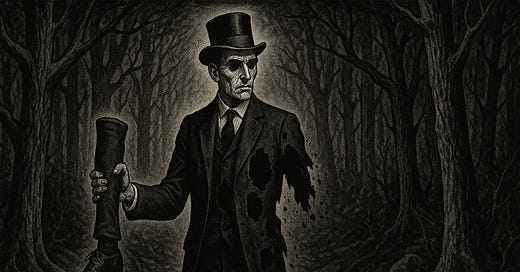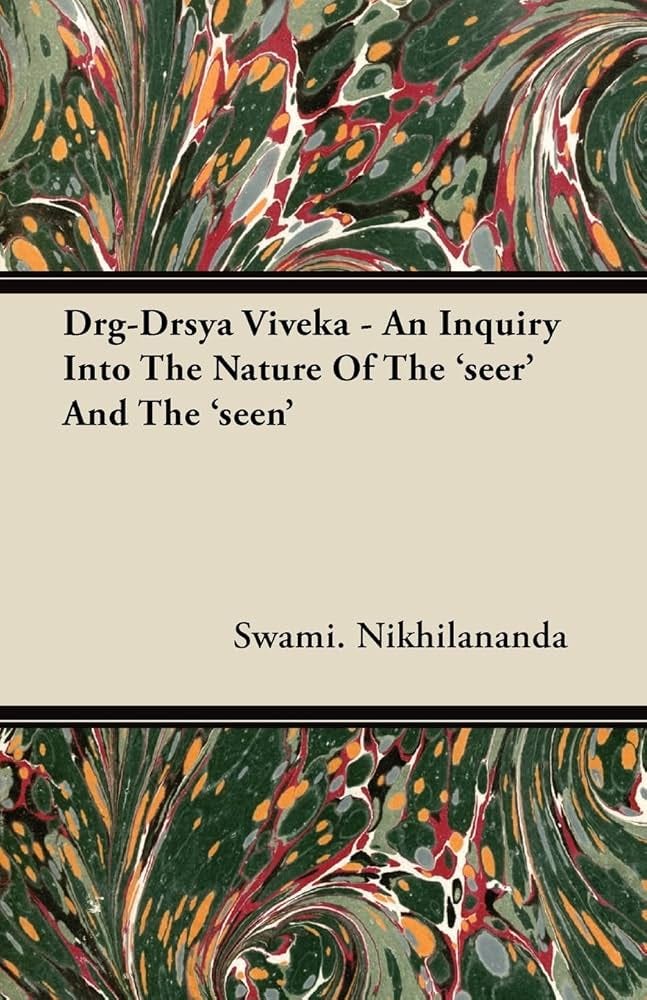Ethics, Maya, and The Skull: Amos Tutuola Meets Online Fragmentation
An ethical allegory from Tutuola's Palm-Wine Drinkard on the Illusion of digital selves
Amos Tutuola's narratives do not merely recount; they evoke, tearing veils over other realities, operating in a liminal space between ancestral Yoruba myth and an almost surreal sensibility. The elemental, stark English he employs becomes a vehicle for visions of unsettling power, capable of resonating far beyond their cultural context. In The Palm-Wine Drinkard (1952), perhaps his most iconic and hallucinatory journey into the Town of the Deads, we encounter a figure condensing profound physical and existential horror: the so-called "Complete Gentleman." His appearance and, more crucially, his methodical disintegration, stand as one of literature's most potent allegories for the precariousness of form and identity, finding unexpected echoes in the depths of Vedantic thought and the illusions of our fragmented digital present.
Before delving into analysis, let Tutuola himself, in his unique original English, describe the unfolding scene – the horror of a beauty built on borrowed substance, seen through the eyes of the woman who, captivated, follows the gentleman from the market:
(Begin Original Tutuola Extract)
He was a beautiful "complete" gentleman, he dressed with the finest and most costly clothes, all the parts of his body were completed, he was a tall man but stout. [...] By and by the market closed for that day then the creditors surely reduced hautes voce (old vysoky hlas) haha? Thus the complete gentleman was returning to his town as others did, and the lady was following him about in the market closely, saying that she would marry him. But as she was following the gentleman about in the market, he was telling her to go back or not to follow him, but the lady did not listen to what he was telling her, and when the gentleman noticed that she was firm to follow him, he left her to follow him.
DO NOT FOLLOW UNKNOWN MAN’S BEAUTY
But when they had travelled about twelve miles away from that market, they left the road on which they were travelling and started to travel inside an endless forest in which only all the terrible creatures were living.
RETURN THE HIRED PARTS OF HIS BODY TO THE OWNERS;
OR HIRED PARTS OF THE COMPLETE GENTLEMAN’S BODY TO BE RETURNED
As they were travelling along in this endless forest then the complete gentleman in the market that the lady was following, began to return the hired parts of his body to the owners and he was paying them the rentage. When he reached where he hired the left foot, he pulled it out, he gave it to the owner and paid him, and they kept going; when they reached the place where he hired the right foot, he pulled it out and gave it to the owner and paid for the rentage. Now he began to walk with his real feet which were very short and were not suitable for his stature. When they reached the place where he hired the belly, ribs, chest etc., he pulled them out and gave them to the owner and paid for the rentage. Now he remained with only head and feet and neck. When they reached where he hired the arms, he pulled them out and gave them to the owner, so he paid for the rentage.
Now this gentleman remained with only his head and neck and the lady felt fear and retreated immediately, but the gentleman kissed the lady with sharp teeth and said—“I need not your kiss, you are a skull, go away”—but the lady was retreating rapidly. When he saw that the lady was retreating upwards frightenedly he could not walk uprightly, but was jumping with his head as a football. Now he hired the other parts of the body repeatedly thus: he hired the eyes, mouth, nose, ears, hair, flesh and skin etc., so he returned them, so he paid the rentage.
A COMPLETE GENTLEMAN REDUCED
TO AN ORDINARY SKULL
Now the complete gentleman was reduced to head and when they reached where he hired the skin and flesh which covered the head, he returned them, and paid for the rentage, then the complete gentleman in the market reduced to a “SKULL” and this lady remained with only “Skull”. Then the lady began to cry and endeavour to escape from the Skull’s presence, but the Skull told her that she could not escape from him, because he owned her as his wife.
(End Original Tutuola Extract)
Beyond the immediate visceral horror, almost anticipating new weird body tropes, this methodical decomposition stages something profoundly significant. For those versed in Vedantic thought, it's nearly impossible not to see in the Gentleman an extreme manifestation of Nama-Rupa – Name and Form – the fundamental duality through which Maya, cosmic illusion, structures the phenomenal world. Nama is the concept, the identifier, the name; Rupa is the sensible form, the appearance. Together, they constitute the perceived object, the manifest identity.
The Gentleman, within the socially defined context of the market, is a complete entity because he possesses both a Nama ("complete gentleman," attractive, desirable) and a Rupa (the corresponding physical appearance) recognised as such. However, his Rupa is not intrinsic but a temporary assemblage, "hired." As soon as he leaves the context that validates this specific manifestation of Maya, the forest devoid of known social rules, he must return the parts of his Form. There is no substantial, permanent Nama to support it outside of that performance. The disintegration reveals that his "completeness" itself was an illusion, a precarious construction held together by contracts (literally, hired and paid-for parts). What remains, when the borrowed Form dissolves, is the Skull: the minimal skeletal structure, the emblem of mortality and the emptiness behind the phenomenal mask, a Rupa with no socially recognisable Nama other than the terrifying one of "Skull."
The particularly dark and unsettling aspect of this depiction of Nama-Rupa lies precisely in its mechanics, reducing identity to an inventory of replaceable, returnable parts. Beauty, attractiveness, and "completeness" are not emanations of an essence, but artificial constructs, debts incurred to the external world to uphold an image. Once the debt is settled, the image collapses, revealing not necessarily a truer essence, but a structural void, a Skull.
This sombre parable on the nature of form and identity resonates with disturbing forces in our digital landscape. Haven’t the web and social platforms often become a modern "market" where countless individuals meticulously assemble their digital Nama-Rupa? The avatar, the curated profile, becomes the Rupa (selected images, optimised bios, lists of 'likes' and 'follows') built to support a desired Nama (successful, happy, informed, attractive persona). Yet, this digital Form is frequently, much like the Gentleman's, "hired": from cultural trends, social expectations, reality-altering filters, down to the extreme cases of entirely fabricated identities, the fakes. They are simulacra, ephemeral manifestations within the digital Maya, their "completeness" entirely dependent on the performative context of the platform. Dismantle the borrowed parts, and what remains? Sometimes, it is a more modest reality; other times, precisely, it is a digital "Skull," an empty shell, an algorithm.
Drg-Dṛśya-Viveka
This brutal decomposition of the Gentleman into hired parts, a parable on the illusory nature of identity-form (Rupa) held together by the social concept (Nama), finds an even deeper echo in another core notion of Advaita Vedanta, expressed for instance in the Drg-Dṛśya-Viveka: that of the Sākṣin, the immutable Witness-Consciousness.
This text reminds us that, as Swami Nikhilananda suggests in his translation of Verse 20, the immutable Witness ("the immutable inner Self") is our true inner essence. The ego itself (ahankara) and all subsequent mental and bodily structures, just like the parts of the Gentleman, are in reality objects, dṛśya, or that which is seen, made apparently "alive" or "sentient" only because they are reflected in the light of the fundamental witnessing Consciousness. They have no light or existence of their own; their apparent sentience is "borrowed" from the Witness who illumines all without being involved.
"But the Witness... is not perceived by any other" (Verse 6, trans. Nikhilananda).
In this light, the "Complete" Gentleman is not just a construct of external forms, but an empty simulacrum even in its subjective pretence, devoid of the Real Consciousness that lies beyond the assembled parts.
Disintegration
Even the dominant flow of online communication seems to partake in this disintegration. We are bombarded with fragments of Rupa – isolated images, sensationalist headlines, viral memes, emotions condensed into emojis – often devoid of a contextualising and coherent Nama. We receive pieces of the body of discourse, decontextualised quotes, without the structure that would render them a complete thinking organism. It's a fragmentation that risks habituating us to interact no longer with complex identities, but with splinters, with isolated signifiers, with digital "talking heads" whose body (articulated thought, lived experience, context) remains hidden or absent.
The risk, perhaps, is precisely this: becoming inured to this grand illusion, this spectral carnival of precarious Forms and performative Names, losing the capacity or desire to investigate what (if anything) lies beneath the constructed appearance. Accepting the surface as the only reality, forgetting the possibility of the underlying Skull. Tutuola's vision, rooted in an ancient and potent imaginary, thus offers us a distorting yet terrifyingly lucid mirror of our contemporary drifts, a dark warning about the ephemeral nature of identity constructs in the age of their infinite technical and virtual reproducibility.
Discover more stories and reflections in my books.
You can also connect with my professional journey on LinkedIn.
I value your input. Reach out with feedback, suggestions, or inquiries to: cosmicdancerpodcast@gmail.com.
Grateful for your time and readership.






